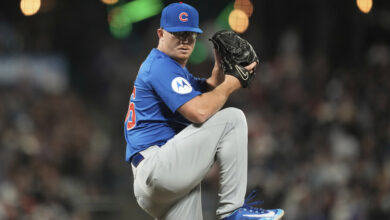
Who Is Justin Stone and What Exactly Does a Director of Hitting Do?
Traditional player development is dead and, barring a zombie apocalypse, it’s never coming back. High-speed cameras, mo-cap sensors, graduate degrees, and computers are taking over. One of the innovators driving that change is Justin Stone, the Cubs’ new Director of Hitting.
The hiring of the Chicago-based hitting guru is a reflection of the Cubs’ inability to develop hitting prospects, particularly those from outside the first round of the draft. Other than their top picks — Albert Almora Jr., Kris Bryant, Kyle Schwarber, Ian Happ, Javy Báez — they have gotten disappointingly little production from the amateur draft. As a result, the Cubs minor league system has been operating at a net loss of $100 million over the better portion of the last decade.
Stone, who founded an extremely successful baseball training institute called Elite Baseball Training, has been brought aboard to fix that. Known for his “BioTech Cage,” a futuristic batting cage with cameras and sensors measuring every minor movement during a swing, Stone will bring cutting edge tech fueled by two decades of coaching and teaching experience to the table.
He was previously was the General Manager at the Chicago White Sox Training Academy from 2001-11 and coached at Indiana State University from 1999-2001, where he also earned his Master’s Degree in Human Performance, specializing in kinesiology, physiology, and biomechanics.
According to the team’s press release, Stone will lead the minor league hitting infrastructure and play a critical role in tracking the progress, adherence, and success of minor league hitting development plans while also serving as hitting coordinator at the lower levels. In short, his goal is to objectively analyze hitters without the bias of outdated coaching dogma. That includes questioning the output of exit velocity and other metrics that are meaningless absent proper context.
“If it takes forever to get up to full speed, [exit velocity] is a moot point,” Stone said.
Báez immediately comes to mind when hearing Stone talk about the kinetic chain. Remember when he was first called up in 2014 and only making contact on 59% of his swings? The doubts were real. Today, Javy’s swing still produces insane exit velocity, but he’s faster to pitches in all areas of the zone. What other Cubs prospects could benefit from a similar mechanical change?
There is a lot of gory math in Stone’s methods, not all of which will necessarily be passed along to the players he’s tasked with developing. Below is an example of his training examination, during which his lingo alternates between kinesiologist and grungy hitting coach.
https://youtu.be/VNs7_MK4Eng
What does this tweet even mean?
Very little EMG work has been done in hitting. Taking some hacks in the lab today to check lower body muscle firing patterns. pic.twitter.com/gCYd7HRHHo
— Justin Stone (@elite_baseball) October 17, 2019
It’s cool that Stone was an admirer outside looking into Theo Epstein’s Wrigleyville office even before his days as a consultant. When Stone was working hard at Elite Baseball Training prior to the 2017 season, he was reading The Cubs Way by Tom Verducci and tweeting photos of Epstein quotes. Now, Stone is being tasked with changing the Cubs’ player development culture.
Theo Epstein quote in a book I'm reading. But this is coaching. U have to dig and get to know each player to find out how to best reach them pic.twitter.com/2lJuE800s2
— Justin Stone (@elite_baseball) April 23, 2017
The match between Stone and Epstein seemed inevitable. The Cubs needed an innovative hitting mind capable of instituting and overseeing a massive biotech baseball operation, and Stone was a local Chicago guy who had long admired the work being done on the North Side.
Don’t view this as a quick fix, that’s not what it is by any means. But just as they’ve done with their Pitch Lab, the Cubs are hoping a more aggressive and detailed approach to developing their hitters can pay dividends in the near future.

